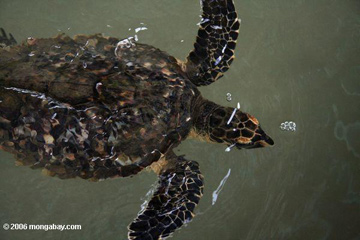Mexican fishing villages work to change practices to preserve loggerhead turtles
Mexican fishing villages work to change practices to preserve loggerhead turtles
University of California – Santa Cruz
October 16, 2007
Small-scale fishing in Mexico rivals industrial fisheries in accidental turtle deaths
SANTA CRUZ, CA–Industrial fishing operations take plenty of blame for both depleting fish stocks and inadvertently catching innocent bystanders such as dolphins, sharks, seabirds, and sea turtles–a phenomenon known as “bycatch.”
But new research shows that a small-scale Mexican fishery–operated by hand from small open boats–can kill as many critically endangered loggerhead sea turtles as all of the industrial fishing fleets in the North Pacific Ocean put together. On a per-hook or per-net basis, the Mexican fishery is 10 to 100 times as deadly, the study found. The research has already resulted in a voluntary turnaround in the fleet’s fishing practices and the declaration of an offshore turtle refuge.
“The impacts of small-scale fisheries have been overlooked because they are inherently difficult to study,” said lead author Hoyt Peckham, a Ph.D. candidate in ecology and evolutionary biology at the University of California, Santa Cruz.

Photo by R. Butler
Sex sells sea turtle conservation in Mexico |
Peckham and colleagues worked alongside Mexican fishermen to simultaneously measure and reduce the accidental turtle catches. Their findings suggest that small fishing operations, which are ubiquitous along coastlines the world over, can have drastic, unintended effects on ocean wildlife such as sea turtles. The work appears in the October 17 edition of the online, open-access journal PLoS ONE.
“It was really surprising to me, because when I think of bycatch I think of massive factory trawlers with huge catch rates decimating the oceans,” Peckham said. “What’s striking in this work is that some small-scale fleets can kill many more turtles, because they fish where turtles are most abundant.”
One such place is off the coast of Baja California Sur, Mexico, where perennially rich turtle feeding waters overlap with a small patch of favored fishing grounds. Local fishermen ply these waters for halibut and other bottom-dwelling fish using gill nets and strings of hooks known as longlines. Their pangas–small boats around 20 feet long–usually fish within about 3 miles of shore, where there are few turtles. But when the fishermen venture farther offshore they share the water with thousands of turtles that spend decades fattening up on the abundant food.
Many turtles are snared inadvertently. Peckham and his coworkers estimated the bycatch at more than 1,000 turtles per year based on their observations accompanying fishermen on day trips and surveying local beaches for washed-up turtle carcasses. Bycatch happens so commonly, Peckham said, that many locals at first didn’t even realize the turtles were endangered.
By comparison, U.S. officials are so concerned about loggerhead turtles that in 2002 they shut down Hawaii’s 20-boat, $55 million swordfish fleet to develop ways to avoid bycatch. The fishery reopened three years later but included an automatic cap that shuts down the season if the fleet as a whole hooks more than 17 turtles. In 2006, the cap was reached just three months into the 10-month season, Peckham said.
Loggerheads are medium-sized sea turtles whose shells reach about a meter (3.3 feet) in length. They live for 50 years or more and nest on beaches in many parts of the world, including the southeastern U.S., the Mediterranean, Oman, Australia, and Japan.
North Pacific loggerheads nest exclusively in Japan, where records from the past 50 years show they are plunging toward extinction. At some nesting beaches, numbers have dropped 50 percent to 90 percent in the last decade. Fewer than 1,500 adult females are thought to nest each year in the entire North Pacific, according to Peckham.
But in addition to those adults, there are many thousand adolescent turtles that spend several decades roaming the North Pacific–and feeding in the waters off Baja California–before beginning to breed. Losing 1,000 or more per year in Mexican waters alone is likely to put a dent in breeding numbers that will be felt decades into the future.
“You can protect hatchlings on beaches all you want, but if you don’t protect juveniles during those 30 years on their foraging habitats, it’s never going to work,” Peckham said.
After realizing the scale of the bycatch, Peckham planned his dissertation research in a way that would help solve the problem. Through the regional conservation network Grupo Tortuguero, he employed Mexican high school and university students to go out on fishing boats and record turtle catches. He set up meetings with local fishermen to brainstorm ways to avoid the problem, including testing alternative fishing gear, bringing Japanese and Hawaiian fishermen to Mexico to share oceanwide perspectives, and spreading the word about bycatch through comic books, impromptu movie showings, murals, and festivals. (See related story at http://press.ucsc.edu/text.asp”pid=1597.)
After seeing the global consequences of their activities, the fishermen quickly made strides to curb their fleet’s impact. Last year, a traditionally rich fishing locale that also produced much of the turtle bycatch was voluntarily made into an off-limits “Fishers’ Turtle Reserve” by the fishermen themselves. Efforts to declare the area an official national reserve with legal protection are under way. And earlier this year, Peckham said, the owner of the area’s biggest fishing fleet chose to retire his longlines from duty in turtle-rich waters.
“In the realm of saving ocean wildlife, we rarely see opportunities as powerful as this,” said Wallace J. Nichols of the Ocean Conservancy, a coauthor of the paper.
“These Mexican fishermen are bringing about probably the biggest reduction in bycatch by any single action that we can imagine. That fleet’s switch away from bottom-set longlines will spare hundreds of loggerheads a year,” Peckham said.
This is a modified news release, originally titled “Small-scale fishing in Mexico rivals industrial fisheries in accidental turtle deaths” from UC Santa Cruz.













